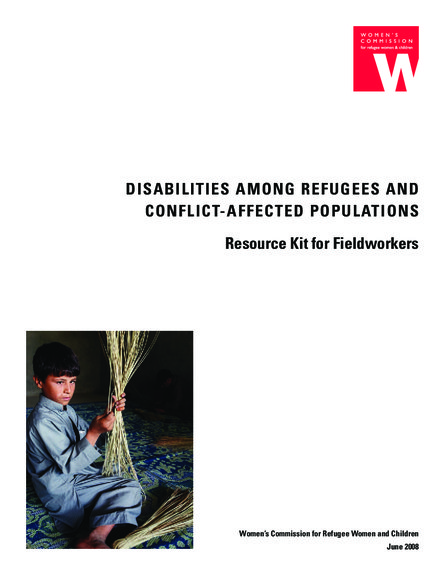Resource Kit for Fieldworkers

Disabilities Among Refugees and Conflict-Affected Populations, the companion report to this resource kit, is the culmination of a six-month project commissioned by theWomen’s Commission for RefugeeWomen and Children and co-funded by the United Nations High Commissioner for Refugees (UNHCR) to address the rights and needs of displaced persons with disabilities, with a particular focus on women (including older women), children and youth. Based on field research in five refugee situations, as well as global desk research, theWomen’s Commission sought to map existing services for displaced persons with disabilities, identify gaps and good practices and make recommendations on how to improve services, protection and participation for displaced persons with disabilities. The objective of the project was to gather initial empirical data and produce a resource kit that would be of practical use to UN and nongovernmental organization (NGO) field staff working with displaced persons with disabilities. While refugees and IDPs with disabilities face enormous challenges, the research was not wholly negative. The Women’s Commission found examples of innovative and successful programs for refugees with disabilities, particularly in the areas of inclusive and special needs education, vocational and skills training, community health care and outreach programs and prosthetics and physical rehabilitation (especially for land mine survivors). We found situations where refugees with disabilities and their families were highly organized and had formed their own self-help support groups. The Women’s Commission also found examples of positive disability awareness programs. Given an accessible physical environment, heightened disability awareness, both within their community and the local host community, and an inclusive approach by agencies assisting them, displaced persons with disabilities can live independent lives, participate fully in public affairs and make positive contributions to their communities. The research found that, in general, services and opportunities for refugees with disabilities were better in refugee camps than in urban settings. Due to the more geographically and socially cohesive nature of refugee camps, it is easier to identify refugees with disabilities, adapt programs to be more inclusive and set up specialized services. It is also easier to effect attitudinal and programmatic change in refugee camps. Urban refugee communities are more dispersed and less physically cohesive. Many urban refugees are undocumented and lack any legal status. They are often afraid of the authorities and prefer to remain “hidden.” This makes it much harder to identify persons with disabilities or to integrate them into mainstream or specialized services. The study showed that less information and fewer services were available for people with mental disabilities than those with physical and sensory disabilities. Refugees with mental disabilities tended to be more “invisible” and “hidden” from public view than those with physical disabilities. They were less likely to be identified in registration and data collection exercises and tended to be more excluded from both mainstream and targeted assistance programs. They were less likely to be included in decision-making processes or in leadership and program management structures.
